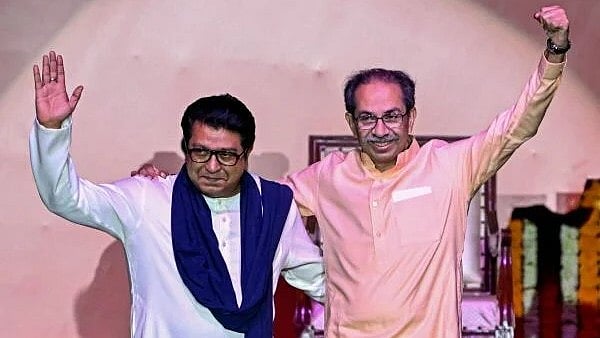
Uddhav Thackeray (R) and Raj Thackeray.
Credit: PTI Photo
On July 16, 2012, when Uddhav suddenly experienced breathlessness and chest pain during his daily routine inside the iconic Matoshree bungalow in Bandra, Mumbai, panic gripped the Thackeray household.
Even before a collective decision could be taken about what had to be done, Shiv Sena supremo, the late Balasaheb Thackeray, dialled his nephew Raj, who was in Raigad district in the coastal Konkan region. “Dadu has been rushed to hospital,” Balasaheb told him, referring to his son, Uddhav.
Without losing a minute, Raj --known as Raja in the family – turned his Mercedes around and raced to Mumbai to reach Lilavati Hospital and Research Centre. That evening, he drove Uddhav back home and then headed for his home, Krishna Kunj, off Shivaji Park at Dadar. Photographs of the smiling cousins at Matoshree’s doorstep, seven years after their split, were splashed across newspapers.
The Thackeray family has always been closely knit. Uddhav’s father, Balasaheb, and Raj’s father, the noted music composer Shrikant Thackeray, were brothers. Uddhav’s late mother, Meenatai, and Raj’s mother, Kundatai, were sisters.
Uddhav (65) and Raj (59) grew up together under Balasaheb’s tutelage, imbibing lessons in politics, art, literature, and culture -- and the distinctive style often known as the Thakeri language.
When the cousins parted ways in 2005, the political landscape in Maharashtra and India was very different. Uddhav took charge of the Shiv Sena, founded by his father, while Raj launched Maharashtra Navnirman Sena (MNS) in March 2006.
However, 2025 drove changes within the Shiv Sena (Uddhav Balasaheb Thackeray), commanded by Uddhav following the split of the Shiv Sena engineered by once-ally BJP through Eknath Shinde and also the MNS.
The question now is whether Uddhav and Raj would come together after 20 years, as there are indications of a Sena (UBT)-MNS electoral alliance.
Once, Raj and Uddhav sat on either side of Balasaheb at public functions and were inseparable. Raj was charismatic, a cartoonist and caricaturist and an excellent orator like Balasaheb, while Uddhav was an excellent photographer who was calm and composed.
The differences among the cousins started in the early 2000s. In February 2003, it was Raj himself who had proposed Uddhav’s name as executive president of the Shiv Sena when Balasaheb began to scale back his workload. But soon after, differences surfaced. Balasaheb made repeated efforts to reconcile the two -- even invoking the Marathi poem Ya chimanyano parat phira re (birds, come back to the nest) in a Saamana editorial – but the break proved permanent. However, both chose to keep personal relationships aside and moved on.
Over the years, Uddhav and Raj crossed paths only at family gatherings, occasionally taking public potshots at each other. However, Raj honoured Uddhav’s invitation in November 2019 and attended his swearing-in as Chief Minister of the Maha Vikas Aghadi (MVA) coalition -- comprising the undivided Shiv Sena, Congress and the Sharad Pawar-led undivided NCP -- marking a thaw of sorts.
The political situation changed again after the 2022 Shiv Sena split engineered by the BJP through Eknath Shinde and the 2023 NCP split led by Ajit Pawar. The MVA had performed creditably in the 2024 Lok Sabha polls, though Raj did not contest and supported Prime Minister Narendra Modi. However, both cousins suffered setbacks in the subsequent Assembly elections in 2024 — Uddhav’s UBT faction won just 20 seats, while the Raj-led MNS, who contested independently, failed to open an account. The MNS won 11 seats in 2009 and one each in 2014 and 2019.
Earlier this year, Uddhav and Raj appeared together at several events, united on the issue of promoting the Marathi language. They have been seen together at least eight or nine times in recent months, rekindling hopes among party cadres of a broader political reunion.
The Shiv Sena (UBT) wants MNS to be included in the MVA in the run-up to the Maharashtra mega local body elections, but the Congress leaders are opposed to it, fearing Raj’s previous positions -- on migrants, particularly those from Uttar Pradesh and Bihar, and the loudspeaker controversy -- could alienate urban minority votes. The Congress leadership also fears the partnership may have a negative impact in the local polls, as Maharashtra’s urban pockets of Mumbai, Thane, Pune, Nashik, Chhatrapati Sambhajinagar, Nagpur and Amravati house a large migrant population. Yet another concern of the Congress is Raj’s proximity to Maharashtra Chief Minister Devendra Fadnavis.
Still, for many Maharashtrians and the workers of Shiv Sena (UBT) and MNS, the possibility of the Thackeray cousins joining hands is an emotional issue. Such a reunion, however, is definitely a concern for Shinde, the former chief minister and now Deputy CM, who commands the Shiv Sena.
The Thackeray-brand -- a blend of charisma, cultural pride, and street-level
connection – continues to hold a special place in Maharashtra politics. Whether that legacy now takes a new, united form remains to be seen.